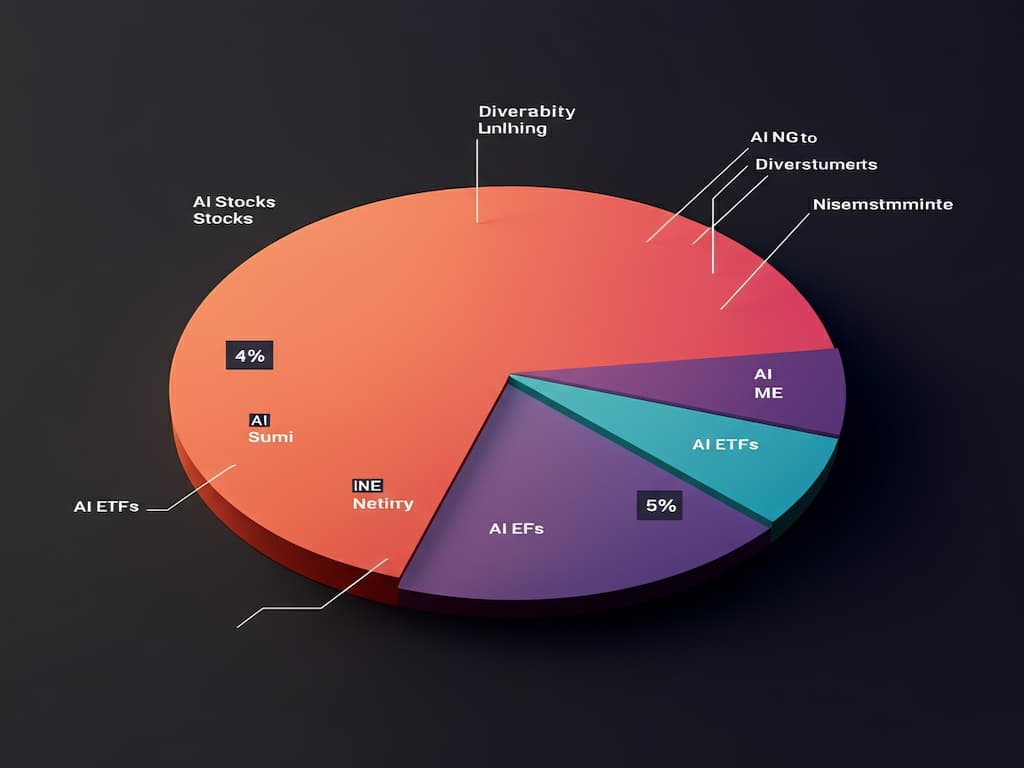Artificial intelligence (AI) is not just changing industries. It’s also creating exciting opportunities to invest in AI. From self-driving cars to smart assistants and predictive analytics, AI is shaping the future.
But how can you, as a beginner, invest in AI and benefit from its rapid growth?
This guide will walk you through how to invest in AI step by step. You’ll learn everything from selecting the right stocks to building a diverse portfolio. By the end, you’ll have a clear plan to start growing your wealth by investing in AI.
What Makes AI a Great Investment?
AI investment isn’t just about jumping on a trend; it’s about backing innovation that is revolutionizing the way we live and work. Here are four reasons investing in AI is a great idea:

High Growth Potential:
Experts believe the AI industry could grow to $1.8 trillion by 2030.
Learn more about the economic potential of generative AI in this McKinsey report.
If you invest early, you could gain a lot from this rapid growth.
Wide Applications:
AI is already helping in fields like healthcare, finance, marketing, and transportation.
Companies using AI to work better and earn more are likely to succeed in the long term.
Innovation and Disruption:
AI companies are changing industries by automating tasks and building smarter tools.
This creates big opportunities for early investors.
Compound Returns:
AI companies that focus on research and development often make great profits over time.
Starting sooner can help you gain more from the growth potential.
Now that you know the benefits, it’s a great time to begin your AI investment plan.
Step 1: Learn the Basics of AI Investing
AI Stocks:
You can buy shares in companies that focus on AI. This includes big names like Nvidia and Google (Alphabet) or smaller startups with innovative ideas.
Learn more about Nvidia’s official investor relations page for detailed financial and stock information.
AI ETFs (Exchange Traded Funds):
ETFs, like the “Global X Robotics & Artificial Intelligence ETF,” allow you to invest in multiple AI companies at once. This gives you instant diversification.
AI Startups:
Are you interested in private companies? Platforms like AngelList make it easy to invest in early-stage AI startups.
Robo-Advisors:
Platforms like Wealthfront use AI to help manage and grow your portfolio automatically.
Pro Tip: Always take the time to research and understand your investments before moving forward.
Step 2: Choose the Right AI Stocks or Funds
To choose where to invest, focus on companies or funds with strong potential. Here’s how:
- Consider Industry Leaders: Companies like Microsoft, Amazon, and Nvidia are heavily invested in AI.
- Diversify by Sector: Explore AI in industries like healthcare (Medtronic), finance (Square), and manufacturing (ABB).
- Check Financials: Look at balance sheets, profits, and R&D spending. Strong AI investments matter.
- Explore AI ETFs: Beginners can reduce risk with funds like BOTZ or ROBO, which offer broad industry exposure.
By diversifying and focusing on solid performers, you balance risk with growth potential.
Learn more about Global X Robotics & Artificial Intelligence ETF for more details on this fund.

Step 3: Open an Investing Account
If you’re new to investing, the first step is to open a brokerage account. Here’s how:

- Choose a Platform: Use beginner-friendly platforms like Robinhood, E*TRADE, or Fidelity. AI-focused tools like Wealthfront or Betterment are also great options.
- Fund Your Account: Start small, even with just $100, and add more as you gain confidence.
- Buy AI Stocks or ETFs: Search by ticker symbols like NVDA (Nvidia) or BOTZ (Global X AI ETFs).
- Set Long-Term Goals: Decide how AI investments fit your financial plans, whether for retirement or short-term gains.
Invest regularly and hold for the long term to help balance market ups and downs.
Step 4: Keep Learning and Monitoring
Stay Updated: Follow industry news on AI advancements like ChatGPT and self-driving technology.
Track Metrics: Keep an eye on quarterly earnings and product updates from your investments.
Rebalance Regularly: Adjust your portfolio periodically to maintain the right AI exposure.
Spending time each week reviewing and refining your strategy can boost your investment results.
Common Mistakes to Avoid
Do Your Research: Don’t buy stocks based on hype. Always check a company’s fundamentals.
Know the Risks: AI is a high-growth but volatile sector. Match your investments with your risk tolerance.
Diversify: Avoid putting all your funds in one sector or company.
Be Patient: AI investing needs a long-term approach. Give your investments time to grow.
Avoid these mistakes to build a stronger foundation for long-term success.
Step 5: Take Action Today
AI is rapidly transforming industries and creating unprecedented opportunities for investors. Don’t wait too long to get started. Even small investments can grow significantly over time when invested wisely.
Whether you’re buying AI ETFs, individual stocks, or using AI-powered apps, the key is consistency and learning along the way.
Remember: The first step toward building wealth is simply getting started.
Are you ready to take the leap into the world of AI investing?
Subscribe to our blog for more expert tips, guides, and updates about how to invest in AI. Stay ahead of the trend and build your portfolio today!
Blog
This section provides an overview of the blog, showcasing a variety of articles, insights, and resources to inform and inspire readers.
-

Simple Ways to Teach Kids About Money at Home
Teaching kids about money is an essential life skill that sets the foundation for…
-

The Real Cost of Raising Kids in 2025 (And How to Prepare for It)
Raising children has always been a significant financial commitment, but as we head into…
-

How to Stretch Your Grocery Budget Without Sacrificing Nutrition
Rising grocery prices can feel overwhelming, especially when you’re trying to feed a family…

Leave a Reply